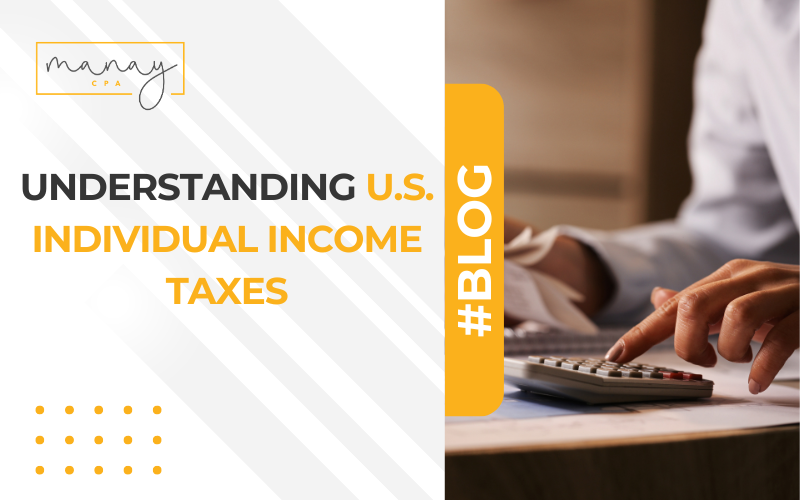Understanding U.S. Individual Income Taxes

It is crucial to understand the nuances of the U.S. tax system as the complexities of U.S. individual income taxes vary depending on whether you’re a seasoned taxpayer, a freelancer, a student, or filing your taxes for the first time. This guide covers U.S. individual income tax, the tax implications of freelancing, tax brackets, tax deductions, forms you may need to fill out, and even how to avoid common tax mistakes.
We’ll break down every component of the U.S. individual income tax and equip you with the knowledge you need to file your tax returns confidently.
Table of Contents
ToggleWhat is U.S. Individual Income Tax?
The United States levies tax on its citizens and residents based on their worldwide income. Non-resident aliens are also taxed on their income from U.S. sources and any income that’s connected with a U.S. trade or business. This individual income tax is levied progressively in tax brackets – as your income goes up, the tax rate on the next bracket of income is higher.
Who needs to file a U.S. individual income tax return?
If you are a U.S. citizen or permanent resident working in the United States, you must file income tax returns for earnings both within and outside the United States. For self-employed individuals, you’ll be required to file individual income tax returns if your gross income is over the filing requirement or if you have over $400 in net earnings from self-employment.
Note that non-U.S. citizens who earn income from U.S. sources are generally required to file a U.S. income tax return. This includes non-resident aliens who are engaged in a trade or business in the United States, or who have U.S. income on which the tax liability was not satisfied by the withholding of tax at the source. Non-resident aliens are also required to file a U.S. tax return if they want to claim a refund of withheld or overpaid tax or claim the benefit of any deductions or credits.
When are U.S. tax returns due?
The filing deadline to submit tax returns or an extension to file and pay tax owed is April 15 of the year following the eligible tax year. For the 2023 tax year, Tax Day falls on Monday, April 15, 2024.
What are the different tax brackets for U.S. individual income tax?
In 2023 and 2024, there are seven federal income tax rates and brackets: 10%, 12%, 22%, 24%, 32%, 35%, and 37%. Taxable income and filing status determine which federal tax rates apply to you.
How can I calculate how much U.S. income tax I owe?
To calculate how much U.S. income tax you owe, you first need to calculate your adjusted gross income (AGI) – this is your total household income, excluding certain items such as contributions to your 401(k). From AGI, you subtract exemptions and deductions (either itemized or standard) to get your taxable income. Your taxable income is then multiplied by the tax rate in your tax brackets to calculate your federal income taxes owed for the year.
What are some common deductions I can claim on my U.S. individual income tax return?
You can claim credits and deductions on your individual U.S. income tax returns to lower your tax liability. The IRS has a comprehensive list of credits and deductions. However, the eligibility for tax credits and deductions differs between individuals depending on their specific circumstances. Always consult a tax professional to ensure you fully take advantage of all tax credits and deductions that you’re eligible for.
Some of the common deductions that U.S. individual taxpayers may claim include:
- Medical and dental expenses over 7.5% of your adjusted gross income
- Student loan interest
- State and local income or sales taxes, real estate, and personal property taxes
- Home mortgage interest
- Personal casualty and theft losses from a federally declared disaster
- Gifts to a qualified charity
What is the difference between the standard deduction and itemized deductions?
When you file your tax return, you generally have two options – claim the standard deduction or itemize your deductions. The standard deduction is a fixed amount determined by the IRS based on your filing status. If you claim the standard deduction, you’ll simply enter the available standard deduction on your Form 1040.
On the other hand, itemized deductions are what you actually spend on certain deductible expenses, such as medical expenses, state and local taxes, mortgage interest, and charitable deductions. If you itemize, you’ll need to list each of these expenses on your Schedule A and attach it to your tax return.
Consider consulting with a tax professional to assess your deduction options and determine which method may benefit you more.

Can I claim my dependents on my U.S. tax return?
Yes, you can claim your dependents on your U.S. tax returns. They must be a qualifying child or relative who relies on you for financial support – you can’t claim your spouse as a dependent if you file jointly. For a qualifying child, they must be directly related to you and be under the age of 19 or 24 if a full-time student, or any age if permanently disabled. They should also receive more than half their financial support directly from you and must have resided with you for more than half the year.
How are capital gains taxed in the United States?
The taxation of capital gains in the United States is dependent on the total taxable income. From 2023, the majority of individuals will not have a tax rate higher than 15% on most net capital gains.
You won’t pay any capital gains if your taxable income is equal to or less than:
- $44,625 for single and married filing separately,
- $89,250 for married filing jointly and qualifying surviving spouse, or
- $59,750 for head of household.
You’ll incur a 15% capital gains rate if your taxable income is more than the above-mentioned thresholds but less than or equal to:
- $492,300 for single,
- $276,900 for married filing separately,
- $553,850 for married filing jointly and qualifying surviving spouse, and
- $523,050 for head of household
A 20% rate will apply if your taxable income exceeds the thresholds set for the 15% capital gain rate.
For short-term capital gains, you’ll be taxed as though it were ordinary income subject to progressive tax rates.
What Types of Income are Taxable in the United States?
Unless specifically exempted by the law, most income is taxable. These are the types of income taxable in the United States:
- Employment income as indicated on your W-2
- Business income from partnerships or other business ventures
- Self-employment income or any other similar side jobs
- Income from investments, such as capital gains, dividends, stock options, etc.
- Any benefits you receive, including retirement, Social Security, unemployment benefits, etc.
- Any other monies you receive that contribute to your regular income, such as alimony, gambling winning, canceled debts, awards, etc.
What tax forms do I need to file my U.S. individual income tax return?
Primarily, you’ll use Form 1040 to file your U.S. individual income tax return. It’s used to calculate income, deductions, credits, tax refunds, or taxes owed to the IRS. And if you’re a senior citizen, you’ll file Form 1040-SR. Note that Form 1040 has several schedules and variants you may need to fill out depending on your type of income and the type of deductions you opt for. They provide additional information and details about income, deductions, and credits that you report on your Form 1040. If you don’t understand which one or how you’re supposed to fill out Form 1040, tax professionals can help you file individual income tax returns.
Where can I find information about the IRS for individual taxpayers?
The two most convenient ways to find information about the IRS for individual taxpayers are from the IRS website and consulting tax professionals.
The IRS website provides a wealth of information for individual taxpayers on a variety of tax-related issues, including how to file your taxes, understanding your rights as a taxpayer, and getting help with tax questions. Simply search the website for any information you need. You can also contact your local IRS office for more specific tax-related inquiries.
What happens if I owe money on my U.S. tax return?
If you owe money on your U.S. individual income tax return, the balance is subject to interest and a monthly late payment penalty. The IRS charges a penalty for various reasons — if you don’t file your tax return on time, if you don’t pay any tax you owe on time, or if you prepare an accurate return. If you don’t pay enough tax through withholding and estimated quarterly tax payments, you may have to pay a penalty. If you don’t pay the tax you owe by your original filing due date, the balance is subject to interest and a monthly late payment penalty. There’s also a penalty for failure to file a tax return, so you should file in a timely manner even if you can’t pay your balance in full.
What are estimated tax payments, and who needs to make them?
Estimated tax payments are used to pay not only income tax but other taxes such as self-employment tax and alternative minimum tax. Individuals, including sole proprietors, partners, and S-corporation shareholders, generally have to make estimated tax payments if they expect to owe tax of $1,000 or more by the time they file their individual tax returns. Note that if you don’t pay enough tax through withholding and estimated tax payments, you may have to pay a penalty.
What are the penalties for filing a late U.S. tax return?
Generally, the failure to file a penalty ranges from 5% to 25% of the unpaid taxes. While you can dispute the penalties if you don’t agree with the amount imposed, the IRS can also forgive or lower the penalties if you show a reasonable cause as to why you couldn’t meet your tax obligations.
What should I do if I receive an IRS notice?
If you receive an IRS notice, don’t ignore it. The notice will explain the reason for the contact and give you instructions on how to proceed. If you agree with the information, there is no need to contact the IRS. However, if you don’t agree, you should respond as directed in the notice.
If your notice requires a response by a specific date, you should reply in a timely manner to minimize any further penalties and to preserve your appeal rights if you don’t agree. But in case you don’t know what to do next, contact a tax professional for IRS representation.
How can I avoid common tax mistakes?
Avoiding common tax mistakes can save you money and prevent potential issues with the IRS. Here are some tips:
- Review all numbers and information for accuracy.
- Accurately report your financial information exactly as it is reported to the IRS on forms such as the W-2, 1099, etc.
- Be sure to select the correct filing status for your situation.
- Contribute the maximum allowed amount to tax-advantaged accounts, such as IRAs and 401(k)s, to save on taxes.
Do I need to hire a tax professional to file my U.S. individual income tax return?
The decision on whether or not to hire a tax professional to file your taxes entirely depends on the complexity of your tax situation and personal preferences. If your tax situation is relatively straightforward,, you might be able to handle your taxes on your own using tax software of your choice.
However, if you have a more complex tax situation — if you own a business, sold investments, worked in multiple states, or have other complicated tax issues — you may want to consider hiring a tax professional. This not only ensures you avoid making any errors but that you also take advantage of all tax credits and deductions that you qualify for. They can provide valuable tax planning strategies, help you understand new tax laws, and represent you before the IRS in case of an audit.

What are the tax implications of freelancing in the United States?
As a freelancer, you are considered self-employed, which means you are responsible for paying your taxes, including income tax and self-employment tax. Here’s a breakdown of the tax implications of freelancing in the United States:
- Income Tax: You’ll need to calculate the net profit or loss from your business to determine how much income tax you should pay.
- Self-Employment Tax: You are subject to self-employment tax, which covers Social Security and Medicare taxes. As a freelancer, you’re responsible for paying the full amount, unlike employees who share the cost of these taxes with their employers.
- Estimated Tax Payments: The IRS requires freelancers to make estimated tax payments quarterly to cover both income tax and self-employment tax.
- Eligible tax deductions and credits: As a freelancer, you can claim deductions for all business-related expenses, reducing tax liability.
- Tax forms: You’ll need to fill out a Schedule C (Form 104, Profit or Loss from Business) and a Schedule SE (Self-Employment Tax) when filing your tax return.
FAQs
Can I file my U.S. individual income tax return electronically?
Yes, you can file your U.S. individual income tax return electronically using the IRS e-file option.
What tax software is available for U.S. individual income tax preparation?
There are several tax software options available for preparing and filing your U.S. individual income tax return. Some of the top online tax software platforms include TurboTax, H&R Block, TaxSlayer, Jackson Hewitt, Cash App Taxes, etc. If you are unsure which software to choose for your tax needs, consider asking a tax professional.
How can I claim student loan interest on my U.S. tax return?
Yes, you can claim student loan interest on your U.S. tax return by deducting either$2,500 or the amount of interest you paid during the year — whichever balance is lower. Your federal loan servicer will issue you with a Form 1098-E if you paid interest (both required and voluntarily) on a qualified student loan during the year.
What are the tax benefits of owning a home in the United States?
Homeowners in the United States enjoy significant tax deductions and credits. Some of the most notable tax deductions for U.S. homeowners include deductions for mortgage interest, property taxes, and home sale exclusion. Tax credits available to homeowners include credits for deductions for energy-efficient upgrades, residential clean energy, and home improvements.
How can I report foreign income on my U.S. tax return?
All U.S. citizens and non-resident aliens with foreign income are obligated to report it in their U.S. tax returns. You’ll use the standard Form 1040 for filing individual income tax returns, on which you report your foreign income where you normally report your U.S. income, and use Schedule B (Form 1040) to report interest and ordinary dividends. You’ll also need to file Form 114 with the Treasury Department if, at any time during the year, you’ve had an interest in or been a signatory or other authority over foreign financial accounts where the total value exceeded $10,000.
Conclusion
Whether you’re filing your taxes for the first time or you’ve been doing it for years, we’ve broken down everything you’ll need to know to seamlessly file your U.S. individual income taxes, including which mistakes to avoid, the penalties of late filing, and what to do if you receive an IRS notice.
Given that the complexity of individual taxes varies from one person to another, it’s always a good idea to consult tax professionals for more personalized advice.
Published on: 04 April 2024
Last updated on: 04 April 2024
Manay CPA is a reputable, full-service CPA firm based in Atlanta, Georgia. Founded in 2001, we provide comprehensive accounting and tax solutions to individuals and businesses across all 50 states.





